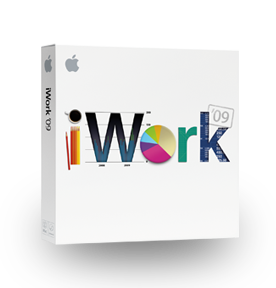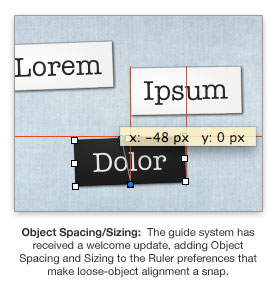
Upgrading?
Our Keynote Themes and Pages Templates, including both iWork '08-compatible and older editions, should continue to work without issue in the newest version of iWork. Our '08 Edition themes and templates in particular shouldn't require updates this cycle...
iWork '09: Preliminary Upgrade Report
Last Updated 06.11.2009
Apple's iWork '09 package, containing Keynote 5.0, along with Pages 4.0 and Numbers 2.0, first became available January 6th, 2009. While scheduling didn't allow us to prep this report until well later in the year, we've spent a lot of time inside the updated applications since the rollout exploring the new features and any potential compatibility issues with our older themes/templates to be aware of.
We're pleased to report that you shouldn't encounter any issues running your older Keynote themes or Pages template files in the newer iWork '09 versions, especially if you're using our '08 Edition themes. iWork '09 builds on the architectural shift that iWork '08 initiated, adding new features on the application level and new definitions to the supporting XML structure - as such, there's no need for the fundamental restructuring our most popular themes underwent during the adoption of iWork '08. In short, we can focus on new ideas for a while and let the '08 editions stand; we'll be pulling some of the back catalog (Keynote "Classic" architecture) forward to the new architecture as the year progresses - more on that another day :)
If you're running iWork '09 already, we highly recommend applying the 9.0.2 Update - rare instances of file corruption with prior versions have been reported in Apple's Discussion Forums, and though we haven't encountered any such bug first-hand in the months we've been working with '09, it's usually best to err on the side of caution in cases like these and make sure you're running the latest code.
This page will be updated as more information comes to light - check back or let us know if you encounter questions that we have not yet covered. Otherwise, let's have a look at what's new.
Notable Changes: Keynote '09
Keynote has seen a number of notable changes and enhancements coming into '09 - Apple profiles a few of the more significant additions on their What's New in Keynote '09 page, and we recommend you start there if this is your first real look at what the '09 Upgrade brings to the table.
You'll notice some of these changes from the moment you open Keynote: the revised Theme Chooser thoroughly updates the theme selection process, providing scalable icons that respond to mouse positioning (think iPhoto Events) to give you a more comprehensive view of the theme you're selecting, including key master slides, table and charting conventions and font selection. We've adopted the new icon style in our first Keynote '09 release, and our iWork '08 and Classic themes will be updated to make use of the convention in the coming weeks.

The addition of Magic Move and Object-Level transitions brings a lot of new power to Keynote '09, though they may take a bit of getting used to at first. These are, in many ways, a next-step of the object-oriented changes that came into play with Keynote '08: the separation of the background and foreground into distinct, actionable objects opens up a wide range of possibilities in programmatically -driven movements and transitions that the prior architecture couldn't begin to account for. Keynote '09 takes the first steps toward exploring that territory, and Apple's done a fantastic job at making it as easy as possible to setup and execute what would've required an external editor or pre-rendered/pre-compiled video clip (along with the time and skill required to produce) just one generation back. Because of the way these transitions "catalog" the objects on a slide to prepare the transition, we don't recommend using them with Classic Keynote themes (or even mask-based newer themes like Pavilion '08) since the Masking Layer becomes one of those cataloged objects - in short, the illusion breaks very quickly when the "background" starts to move as part of the transition, so be careful to use it only on themes where the background is *really* the background and not a layer *in front* of the background. When used on an object-based deck, though, you can build a stunning custom transition with little more than a slide duplication and edit. In day-to-day use during MagnetBoard production we found that it's best to pre-think the application at least a bit prior to applying the transition the first time, especially if you're using grouped objects: objects that are the product of multiple groupings (i.e. a photo/magnet group that is then grouped with a caption) tend to disappear and reappear (rather than move, rotate or scale as expected) unless the source groups are ungrouped and then regrouped ground-up as a cohesive whole. A bit of attention in this vein during the initial slide build will go a long way toward avoiding unexpected results once the transitions are applied.

Apple highlights a number of other new features in a bit more detail on their What's New page, but we thought we'd devote a bit of space to covering changes/additions that weren't quite as high-profile. The new Guides implementation is, to put it bluntly, a *welcome* improvement over previous generations. Be sure you've turned on both preferences in the Rulers > Object Spacing and Sizing preferences - you may not see it in action much on slide level unless you're moving/arranging/resizing a lot of placed objects around in relation to each other, but when you're working on Master Slides as often as we are you'll notice the improvements almost immediately, as objects are almost constantly tracked against other objects on the stage not just in terms of center/edge alignments as in previous editions, but also in terms of relative spacing between like-sized or like-spaced objects nearby or elsewhere on the stage. Compared to the frustrations of setting consistent (and often numerous) guides in previous versions of Keynote, this may well be our favorite addition to Keynote's workflow, and not only because we'll have to set fewer guides in "dense" themes like PitchBoards. Well done, iWork team :)
Nearly there, but not quite, on another front. The Picture-Frame Stroke model introduced in Keynote '08 enabled the object-based architecture to come into play with the sense of style Keynote users would expect. And while the built-in Picture-Frames covered a wide range of styles right out of the box, we didn't have an option for including our own theme-custom Frames without installing them directly into the Keynote application itself. Keynote '09 pushes these built-ins into a shared library outside of the application itself, yet the frame libraries cannot be referenced inside the theme file's file architecture (like chart textures, for example) and can only be called from this shared directory - meaning that if we installed a custom Picture-Frame along with a theme, it would work just fine: provided you *also* installed the theme on the machine you'll eventually be presenting on or emailing the file to, and so on. We would rather err on the side of caution in a case like this and not include custom Frames if it means one of you might get to showtime only to find that the deck isn't displaying properly on such a root level - we've reached out to Apple on this front and hope that we can arrive at a solution that will enable us to address this at some point in the future, as it will make a big difference in how well we're able to transition a few of our more popular Classic Keynote themes into the newer object-driven architecture.
Notable Changes: Pages
Pages includes the enhanced Template Selector we described earlier (templates will receive point updates in the coming weeks) - a welcome change on the Pages front as well. Pages '09 otherwise grows a bit more into its own alongside Keynote with key usability and workflow enhancements. Apple has a What's New page outlining the major new features and enhancements, and while the Full-Screen View, Dynamic Outlines and MathType/EndNote additions are very welcome additions, from a template perspective we haven't encountered anything new you should be aware of that would impact any on our '08 Edition Templates.
A quiet update is a great update in that respect :)
We have point updates on deck for all three of our Pages Templates sets already - where applicable we'll also add updated Template Selector preview icons, though we may not fully adopt the new style across the board on our '08 templates until their next major revision cycle.
iWork.com
iWork.com offers an easy way to share your Keynote, Pages and Numbers documents with your friends and colleagues around the world whether they're Mac or PC. It's a definite plus for iWork users looking to share their documents in a collaborative online process.
We've tested a number of our themes and templates and haven't noticed anything out of the ordinary - the service is labeled a Beta at this time so your results may vary, but it looks to be a promising addition to the overall iWork workflow model and a natural fit for group review/edits.
Moving Forward
Themes created in Keynote 5 contain an enhanced document structure that is not readable in Keynote 4.x or previous versions - the same is true for templates created with Pages 4. Our current library (excepting MagnetBoard) is compatible with earlier versions of Keynote and Pages as noted on each page's Requirements section - these are all of course compatible with the new iWork '09 versions as well. We're sticking with tradition and producing our new releases only for the most recent version of Keynote: starting with MagnetBoard, our new themes will require iWork '09 - so if you're haven't upgraded, be sure to check the Requirements section of any theme you're considering for purchase.
This page will be updated as more information is available. Last Updated 06.11.2009







